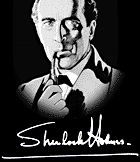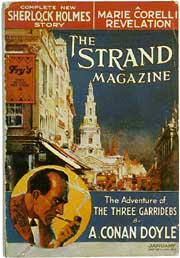

THE CASE-BOOK
OF SHERLOCK HOLMES
 The Strand Magazine from January 1925 with The Adventure of the Three Garridebs |
 The Adventure of the Illustrious
Client
The Adventure of the Illustrious
Client- First published in Collier’s Weekly Magazine, Nov. 1924, with 4 illustrations by John Richard Flanagan, and in the Strand Magazine, Feb.-Mar. 1925, with 8 illustrations by Howard K. Elcock.
 The Adventure of the Blanched
Soldier
The Adventure of the Blanched
Soldier- First published in Liberty, Oct. 1926, with 5 illustrations by Frederic Dorr Steele, and in the Strand Magazine, Nov. 1926, with 5 illustrations by Howard K. Elcock.
 The Adventure of the Mazarin
Stone
The Adventure of the Mazarin
Stone- First published in the Strand Magazine, Oct. 1921, with 3 illustrations by A. Gilbert, and in Hearst’s International Magazine, Nov. 1921, with 4 illustrations by Frederic Dorr Steele.
 The Adventure of the Three
Gables
The Adventure of the Three
Gables- First published in Liberty, Sep. 1926, with 6 illustrations by Frederic Dorr Steele, and in the Strand Magazine, Oct. 1926, with 4 illustrations by Howard K. Elcock.
 The Adventure of the Sussex
Vampire
The Adventure of the Sussex
Vampire- First published in the Strand Magazine, Jan. 1924, with 4 illustrations by Howard K. Elcock, and in Hearst’s International Magazine, Jan. 1924, with 4 illustrations by W. T. Benda.
 The Adventure of the Three
Garridebs
The Adventure of the Three
Garridebs- First published in Collier’s Weekly Magazine, Oct. 1924, with 3 illustrations by John Richard Flanagan, and in the Strand Magazine, Jan. 1925, with 5 illustrations by Howard K. Elcock.
 The Problem of Thor Bridge
The Problem of Thor Bridge- First published in the Strand Magazine, Feb.-Mar. 1922, with 7 illustrations by A. Gilbert, and in Hearst’s International Magazine, Feb.-Mar. 1922, with 3 illustrations by G. Patrick Nelson.
 The Adventure of the Creeping
Man
The Adventure of the Creeping
Man- First published in the Strand Magazine, Mar. 1923, with 5 illustrations by Howard K. Elcock, and in Hearst’s International Magazine, Mar. 1923, with 6 illustrations by Frederic Dorr Steele.
 The Adventure of the Lion’s
Mane
The Adventure of the Lion’s
Mane- First published in Liberty, Nov. 1926, with 7 illustrations by Frederic Dorr Steele, and in the Strand Magazine, Dec. 1926, with 3 illustrations by Howard K. Elcock.
 The Adventure of the Veiled
Lodger
The Adventure of the Veiled
Lodger- First published in Liberty, Jan. 1927, with 4 illustrations by Frederic Dorr Steele, and in the Strand Magazine, Feb. 1927, with 3 illustrations by Frank Wiles.
 The Adventure of Shoscombe Old
Place
The Adventure of Shoscombe Old
Place- First published in Liberty, Mar. 1927, with 7 illustrations by Frederic Dorr Steele, and in the Strand Magazine, Apr. 1927, with 5 illustrations by Frank Wiles.
 The Adventure of the Retired
Colourman
The Adventure of the Retired
Colourman- First published in Liberty, Dec. 1926, with 4 illustrations by Frederic Dorr Steele, and in the Strand Magazine, Jan. 1927, with 5 illustrations by Frank Wiles.
The whole collection of The Case-Book of Sherlock Holmes was published by John Murray in June 1927, in an edition of 15,150 copies. The first American edition was published on the same day by the G. H. Doran Co.
![]()
PREFACE
I FEAR that Mr. Sherlock Holmes may become like one of
those popular tenors who, having outlived their time, are still tempted to make repeated
farewell bows to their indulgent audiences. This must cease and he must go the way of all
flesh, material or imaginary. One likes to think that there is some fantastic limbo for
the children of imagination, some strange, impossible place where the beaux of Fielding
may still make love to the belles of Richardson, where Scott’s heroes still may
strut, Dickens’s delightful Cockneys still raise a laugh, and Thackeray’s
worldlings continue to carry on their reprehensible careers. Perhaps in some humble corner
of such a Valhalla, Sherlock and his Watson may for a time find a place, while some more
astute sleuth with some even less astute comrade may fill the stage which they have
vacated.
![]() His career has been a long one–though it is possible to
exaggerate it; decrepit gentlemen who approach me and declare that his adventures formed
the reading of their boyhood do not meet the response from me which they seem to expect.
One is not anxious to have one’s personal dates handled so unkindly. As a matter of
cold fact, Holmes made his debut in A Study in Scarlet and in The Sign of
Four, two small booklets which appeared between 1887 and 1889. It was in 1891 that
‘A Scandal in Bohemia,’ the first of the long series of short stories, appeared
in The Strand Magazine. The public seemed appreciative and desirous of more, so
that from that date, thirty-nine years ago, they have been produced in a broken series
which now contains no fewer than fifty-six stories, republished in The Adventures,
The Memoirs, The Return, and His Last Bow, and there remain
these twelve published during the last few years which are here produced under the title
of The Case-Book of Sherlock Holmes. He began his adventures in the very heart of
the later Victorian era, carried it through the all-too-short reign of Edward, and has
managed to hold his own little niche even in these feverish days. Thus it would be true to
say that those who first read of him, as young men, have lived to see their own grown-up
children following the same adventures in the same magazine. It is a striking example of
the patience and loyalty of the British public.
His career has been a long one–though it is possible to
exaggerate it; decrepit gentlemen who approach me and declare that his adventures formed
the reading of their boyhood do not meet the response from me which they seem to expect.
One is not anxious to have one’s personal dates handled so unkindly. As a matter of
cold fact, Holmes made his debut in A Study in Scarlet and in The Sign of
Four, two small booklets which appeared between 1887 and 1889. It was in 1891 that
‘A Scandal in Bohemia,’ the first of the long series of short stories, appeared
in The Strand Magazine. The public seemed appreciative and desirous of more, so
that from that date, thirty-nine years ago, they have been produced in a broken series
which now contains no fewer than fifty-six stories, republished in The Adventures,
The Memoirs, The Return, and His Last Bow, and there remain
these twelve published during the last few years which are here produced under the title
of The Case-Book of Sherlock Holmes. He began his adventures in the very heart of
the later Victorian era, carried it through the all-too-short reign of Edward, and has
managed to hold his own little niche even in these feverish days. Thus it would be true to
say that those who first read of him, as young men, have lived to see their own grown-up
children following the same adventures in the same magazine. It is a striking example of
the patience and loyalty of the British public.
![]() I had fully determined at the conclusion of The Memoirs to
bring Holmes to an end, as I felt that my literary energies should not be directed too
much into one channel. That pale, clear-cut face and loose-limbed figure were taking up an
undue share of my imagination. I did the deed, but fortunately no coroner had pronounced
upon the remains, and so, after a long interval, it was not difficult for me to respond to
the flattering demand and to explain my rash act away. I have never regretted it, for I
have not in actual practice found that these lighter sketches have prevented me from
exploring and finding my limitations in such varied branches of literature as history,
poetry, historical novels, psychic research, and the drama. Had Holmes never existed I
could not have done more, though he may perhaps have stood a little in the way of the
recognition of my more serious literary work.
I had fully determined at the conclusion of The Memoirs to
bring Holmes to an end, as I felt that my literary energies should not be directed too
much into one channel. That pale, clear-cut face and loose-limbed figure were taking up an
undue share of my imagination. I did the deed, but fortunately no coroner had pronounced
upon the remains, and so, after a long interval, it was not difficult for me to respond to
the flattering demand and to explain my rash act away. I have never regretted it, for I
have not in actual practice found that these lighter sketches have prevented me from
exploring and finding my limitations in such varied branches of literature as history,
poetry, historical novels, psychic research, and the drama. Had Holmes never existed I
could not have done more, though he may perhaps have stood a little in the way of the
recognition of my more serious literary work.
![]() And so, reader, farewell to Sherlock Holmes! I thank you for
your past constancy, and can but hope that some return has been made in the shape of that
distraction from the worries of life and stimulating change of thought which can only be
found in the fairy kingdom of romance.
And so, reader, farewell to Sherlock Holmes! I thank you for
your past constancy, and can but hope that some return has been made in the shape of that
distraction from the worries of life and stimulating change of thought which can only be
found in the fairy kingdom of romance.
ARTHUR CONAN DOYLE.
![]()